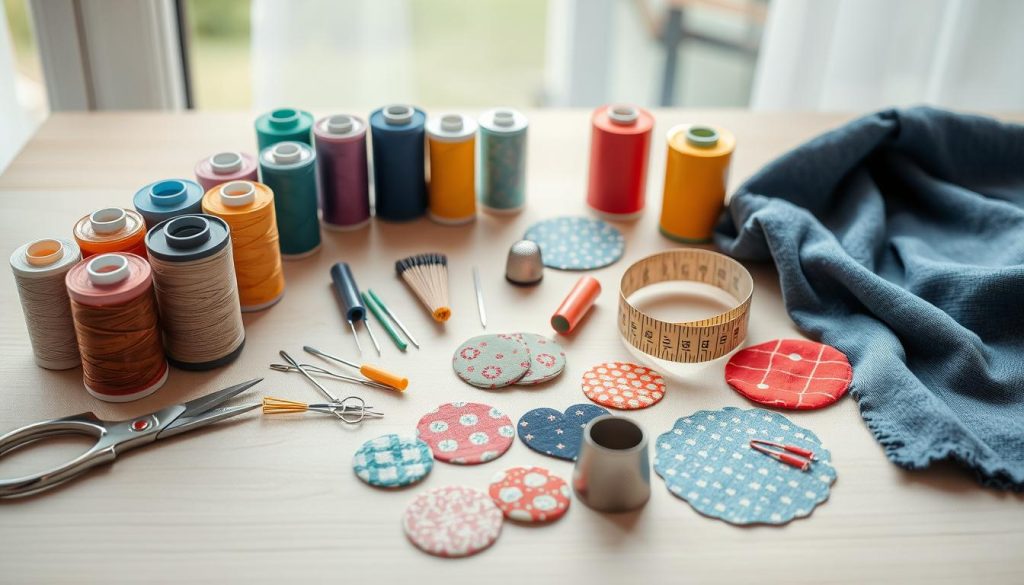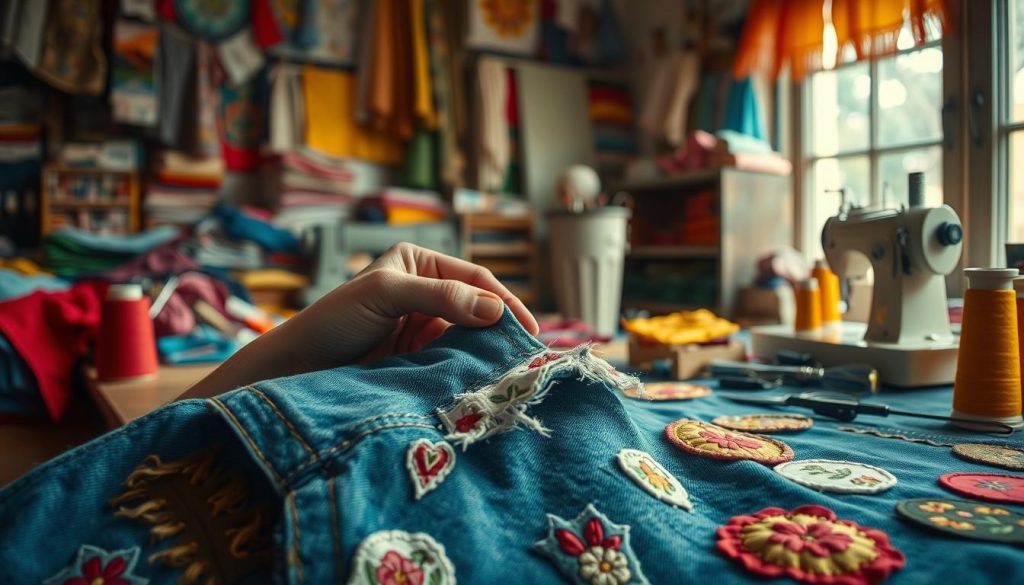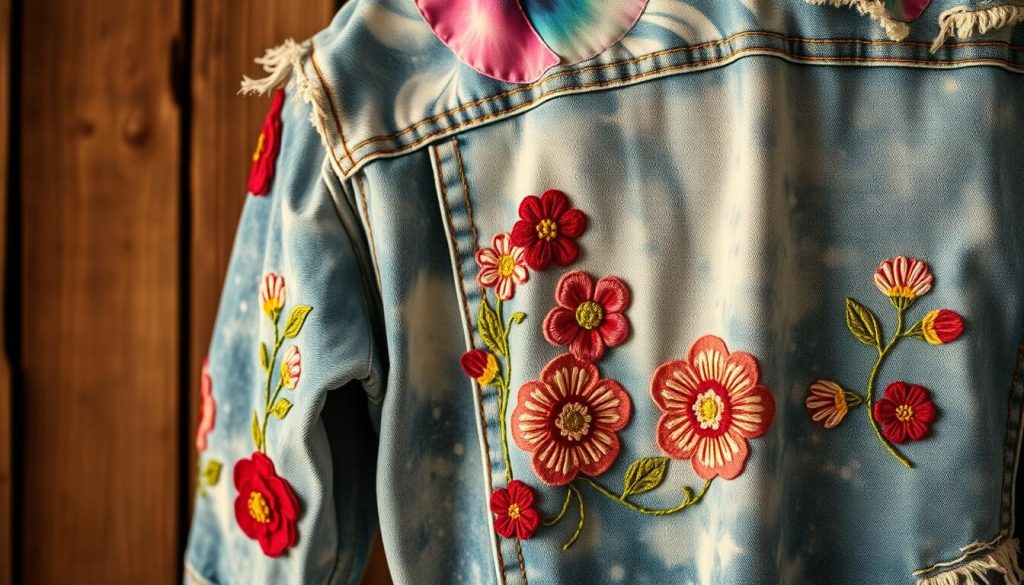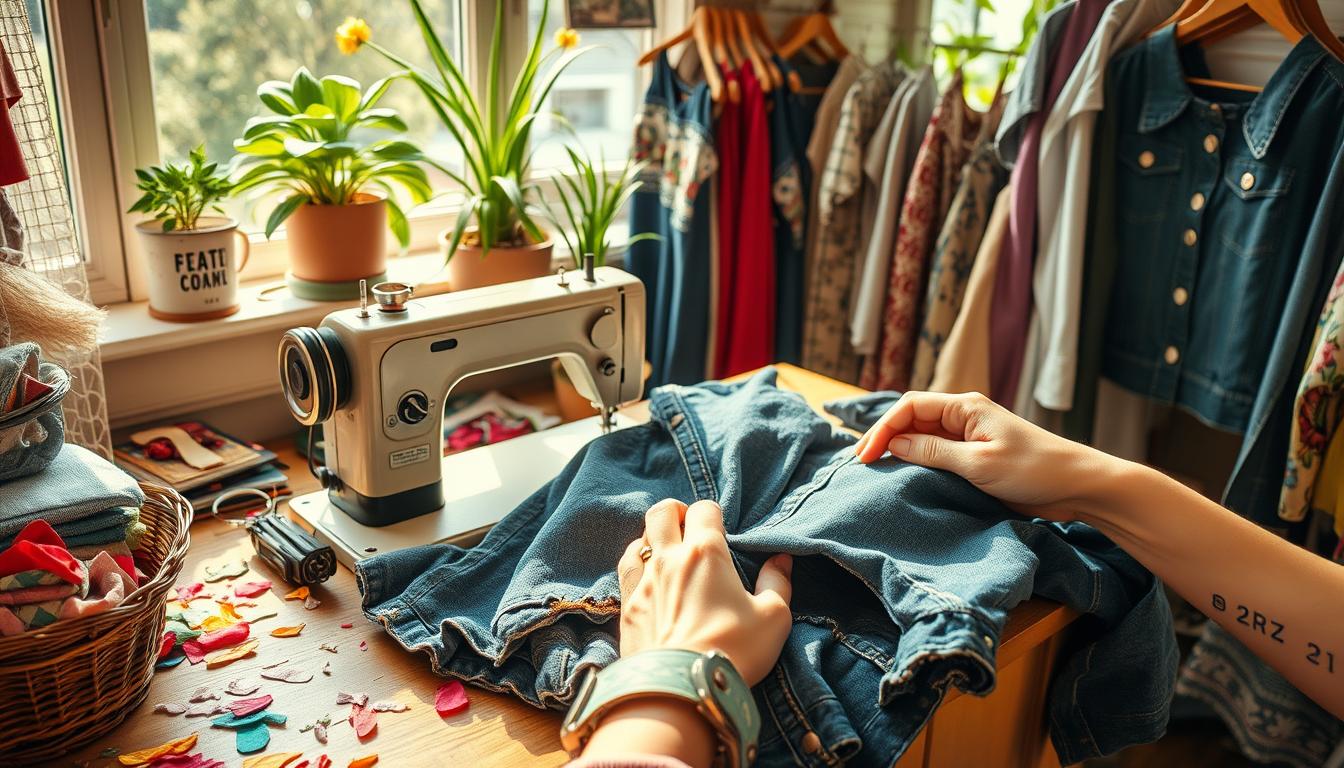I love sustainable fashion. It’s cool how fixing and upcycling clothes can make our wardrobes new again. This way, we save money and cut down on waste.
On my path to a greener wardrobe, I’ve found joy in mending old clothes and making new ones from old pieces. It’s a creative way to show off my style while caring for the planet.
Let’s dive into making our closets better for the Earth. We can do simple repairs or fun upcycling projects. This way, we keep clothes from ending up in landfills and make them look great again.
The Rise of Sustainable Fashion: Why Repair and Upcycle?
Sustainable fashion is becoming more popular. People are choosing to alter their clothes and join the slow fashion movement. They’re moving away from fast fashion and towards eco-friendly choices.
Environmental Impact of Fast Fashion
Fast fashion harms the environment a lot. It creates a lot of waste and uses harmful chemicals. By fixing and upcycling clothes, we can lessen this damage. I’ve started fixing my clothes, and they last much longer.
Economic Benefits of Clothing Repair
Fixing clothes saves money. Instead of buying new, I mend what I have. It’s cheaper and makes me feel proud. Plus, it helps local tailors and shops, boosting the economy.
Cultivating a Unique Personal Style
Upcycling lets us be creative with fashion. I enjoy adding my own touches to my clothes. It makes my style unique and shows who I am. The slow fashion movement supports this individuality.
| Aspect | Fast Fashion | Sustainable Fashion |
|---|---|---|
| Environmental Impact | High waste production | Reduced waste |
| Cost Over Time | Higher long-term costs | Lower long-term costs |
| Style | Uniform trends | Unique personal expression |
| Durability | Lower quality materials | Higher quality, longer-lasting |
Essential Tools for Clothing Repair and Upcycling

I’m excited to share the must-have tools for DIY sewing projects and mending techniques. With these essentials, you’ll be ready to tackle any clothing repair or upcycling adventure!
A reliable sewing machine is first on my list. It’s the backbone of most mending techniques and upcycling projects. If you’re just starting, a basic model will do the trick. For hand sewing, stock up on needles of various sizes and strong thread in neutral colors.
Scissors are crucial for any DIY sewing project. I recommend having fabric shears for cutting cloth and smaller scissors for snipping threads. Don’t forget a seam ripper – it’s a lifesaver when you need to undo stitches!
- Measuring tape
- Fabric chalk or markers
- Pins and pincushion
- Iron and ironing board
These items help ensure precise measurements and smooth fabrics. For patching, I always keep fabric glue and an assortment of patches on hand. They’re perfect for quick fixes or adding a unique touch to your clothes.
Lastly, invest in some quality fabric dyes if you’re interested in giving old clothes a colorful makeover. With these tools at your disposal, you’ll be well-equipped to breathe new life into your wardrobe through creative mending and upcycling!
Basic Mending Techniques Every Fashionista Should Know
I love giving my clothes a new lease on life through simple mending techniques. These clothing alterations not only save money but also reduce waste. Let’s dive into some essential skills every fashion enthusiast should master.
Patching Holes and Tears
Patching is a great way to fix holes and tears in your favorite garments. I start by cutting a piece of fabric slightly larger than the damaged area. Then, I pin it in place on the inside of the garment and sew around the edges. For a decorative touch, I sometimes use visible mending with colorful threads.
Replacing Buttons and Zippers
Loose buttons are an easy fix. I simply reattach them using a needle and thread that matches the original stitching. For broken zippers, I carefully remove the old one and sew in a new zipper of the same size. This mending technique can breathe new life into jackets, pants, and dresses.
Hemming Pants and Skirts
Hemming is a common clothing alteration that can transform ill-fitting garments. I measure and mark the desired length, then fold and pin the fabric. After ironing the new hem, I sew it in place using a straight stitch. This technique works wonders for pants that are too long or skirts that need a style update.
By mastering these basic mending techniques, I’ve extended the life of my wardrobe and developed a deeper appreciation for my clothes. It’s amazing how a few simple repairs can make such a big difference!
Repairing and Upcycling Clothes: A Step-by-Step Guide

I love giving old clothes a new life. It’s not just about saving money. It’s a creative journey that lets me express my style and be kind to the planet. Let me show you some fun DIY sewing projects to start repairing and upcycling clothes.
First, gather your supplies. You’ll need scissors, needles, thread, pins, and fabric scraps. For more advanced projects, a sewing machine can be handy. Now, let’s dive into a simple repair:
- Identify the damaged area on your garment
- Choose a matching thread color
- Thread your needle and tie a knot at the end
- Start stitching from the inside of the garment
- Use small, even stitches to close the hole or tear
- Tie off the thread on the inside when finished
For upcycling, try turning an old t-shirt into a tote bag. Cut off the sleeves, widen the neckline for handles, and sew the bottom shut. Voila! A unique, eco-friendly bag.
Here’s a breakdown of common clothing issues and their solutions:
| Issue | Solution | Difficulty Level |
|---|---|---|
| Missing button | Sew on a new button | Easy |
| Torn seam | Restitch the seam | Easy |
| Hole in fabric | Apply a patch | Moderate |
| Broken zipper | Replace zipper | Advanced |
Remember, practice makes perfect. Start with simple repairs and work your way up to more complex upcycling projects. You’ll be amazed at how your old clothes can transform into unique, stylish pieces!
Transforming Old Jeans: Creative Upcycling Ideas

Denim is a versatile fabric perfect for upcycling clothes. I enjoy finding new ways to give old jeans a new life. Let’s dive into some exciting ideas for repurposing fabrics and making unique pieces.
Denim Skirt Makeover
Turn your old jeans into a trendy skirt. Cut off the legs and open the inseams. Then, sew a panel in the front or back for an A-line shape. Add embroidery or patches for a personal touch.
Jean Jacket Embellishments
Update your denim jacket with creative embellishments. Sew on colorful patches, add studs or rhinestones, or try fabric painting. Upcycling clothes opens up endless possibilities!
Denim Tote Bag DIY
Make a sturdy tote bag from old jeans. Cut out the shape you want, sew the sides, and add straps. This project is great for repurposing fabrics and reducing waste. You’ll get a stylish, eco-friendly accessory.
| Upcycling Project | Difficulty Level | Time Required | Materials Needed |
|---|---|---|---|
| Denim Skirt | Intermediate | 2-3 hours | Old jeans, fabric panel, scissors, sewing machine |
| Jean Jacket Embellishments | Beginner | 1-2 hours | Denim jacket, patches, studs, fabric paint |
| Denim Tote Bag | Beginner | 1-2 hours | Old jeans, scissors, sewing machine, straps |
Breathing New Life into Vintage Clothing
I find joy in finding hidden treasures in thrift stores. Restoring vintage clothes has become my passion. It lets me follow sustainable fashion and show off my style. With a few easy steps, you can turn old clothes into beautiful pieces with a story.
Cleaning is the first step to revive vintage finds. I hand-wash delicate fabrics with mild soap. For tough stains, I make a paste with baking soda and water. This fixes yellowed collars and cuffs well.
Restoring fabrics is key to giving old clothes new life. I use fabric conditioners to soften stiff fibers and prevent damage. For woolens with moth holes, I mend them with matching thread, making the fix almost invisible.
Updating vintage clothes while keeping their essence is an art. I change hemlines or shoulder pads to fit today’s trends. Swapping old buttons or zippers can also make a big difference.
- Replace worn elastic in waistbands
- Reinforce weak seams with invisible stitching
- Use fabric dye to revive faded colors
By restoring vintage clothes, we support sustainable fashion. Each saved piece has a unique story and adds to our style. With patience and creativity, we can make these timeless items shine again.
Eco-Friendly Fabric Dyeing Techniques
Dyeing fabrics is a great way to give old clothes a new life. It also helps reduce waste and supports recycling. Let’s dive into these eco-friendly dyeing methods!
Natural Dyes from Plants and Foods
I love making natural dyes from plants and foods. Many everyday items can create stunning colors. For example, onion skins make lovely yellows and oranges.
Avocado pits and skins give soft pinks. Beetroot creates vibrant reds, and coffee grounds make rich browns. These dyes are kind to fabrics and the planet.
Tie-Dye Revival: Modern Techniques
Tie-dye is back, but with a modern twist! Ice dyeing creates unique patterns. Just place ice cubes on fabric, sprinkle dye, and let the ice melt.
Another fun method is resist dyeing. Use rubber bands or clothespins to make patterns. These techniques are great for upcycling old clothes.
Ombre Effects for a Fresh Look
Ombre dyeing is perfect for updating solid-colored clothes. Start by dipping the bottom in dye, then pull it out slowly. This creates a stunning gradient effect.
It’s an easy way to make plain clothes stand out. It’s great for an eco-friendly wardrobe.
| Dyeing Technique | Materials Needed | Difficulty Level | Best For |
|---|---|---|---|
| Natural Dyes | Plant materials, food scraps | Easy | All fabrics |
| Ice Dyeing | Ice cubes, powdered dye | Medium | Cotton, linen |
| Ombre | Liquid dye, large container | Easy | Long garments, curtains |
Using eco-friendly dyeing techniques helps reduce waste. It’s a fun way to recycle and express our style.
Repurposing Fabrics: From Clothes to Home Decor
I’ve found a cool way to give old clothes a new life. By repurposing fabrics, I turn old clothes into beautiful home decor. It’s a fun, green way to make my home look new and reduce waste.
One fun project is making throw pillows from old t-shirts. I cut them into squares, sew them together, and fill them with recycled stuff. These pillows make my sofa look great and feel cozy. I’ve also made a memory quilt from family clothes, keeping memories alive in a piece of art.
Wall hangings are another great idea. I’ve made colorful tapestries by weaving old clothes on a DIY loom. These add warmth and texture to my walls and give old clothes a new purpose. Repurposing fabrics lets me show off my style in my home and helps the planet.

